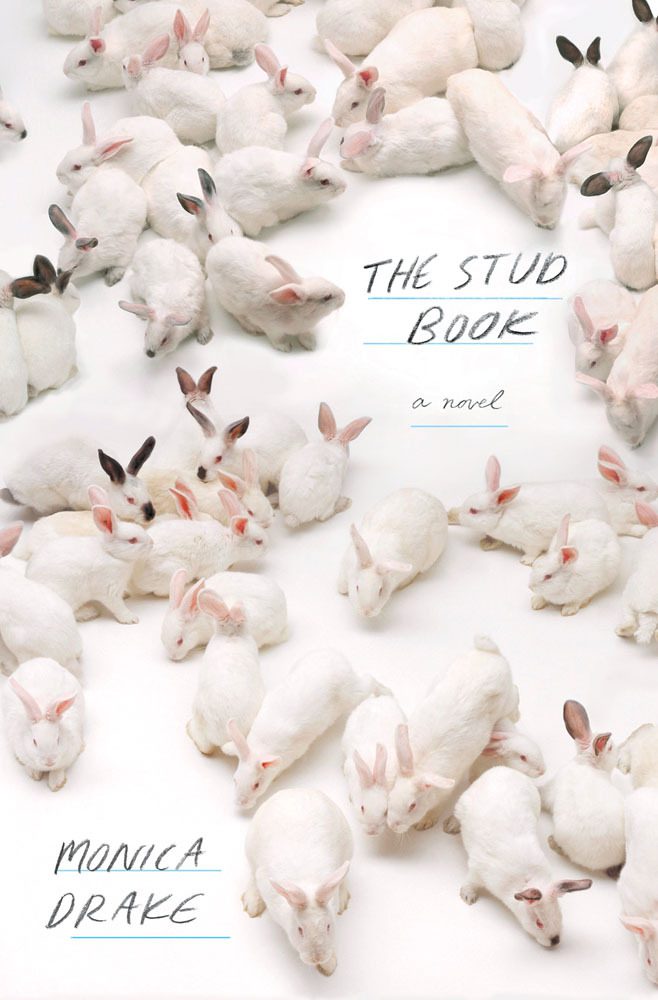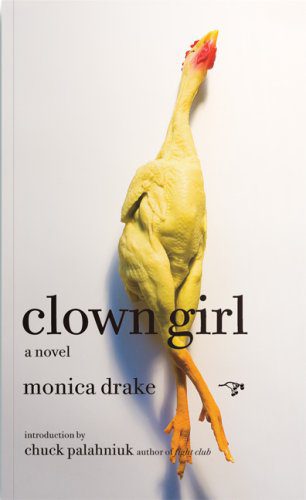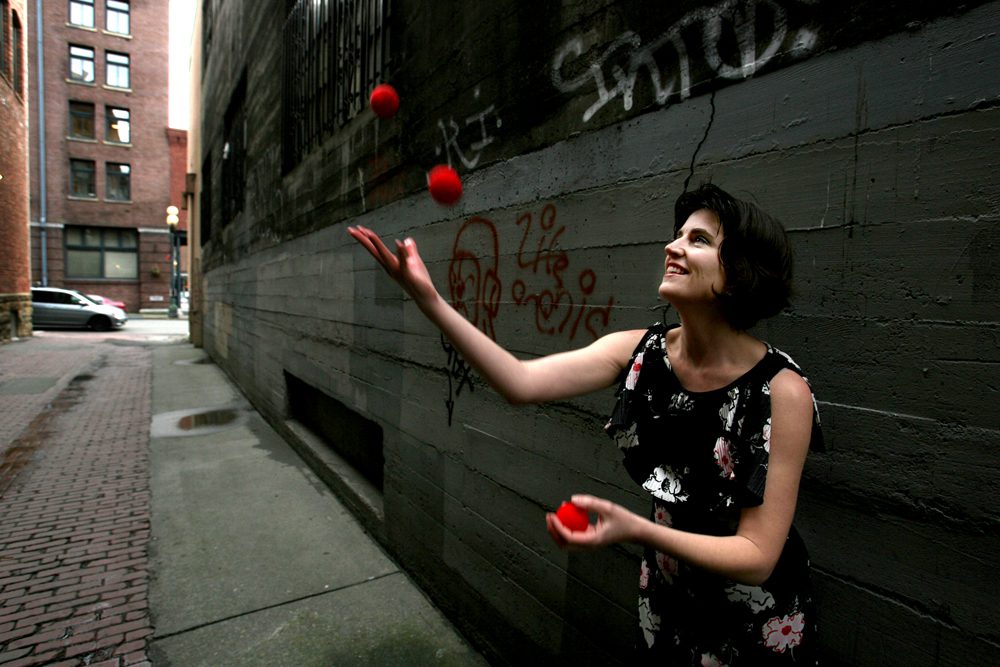Women age—hell, people age—but the issues women face while aging are complicated, and these complications are finely brought to bear in Monica Drake’s The Stud Book. The novel follows the friendships of four women of a certain age, all with different relationships to motherhood. Sarah suffers from fertility issues and is in a deep, bitter sorrow over several miscarriages. Georgie has a newborn and a husband who is strangely absenting himself from their lives, and she’s not sure how to hold onto her professional ambitions. Nyla is a bit of a hippie with a teenage daughter with whom she is struggling to communicate, as she also learns she may be expecting another child. Dulcet is the wild child—no children, no significant relationship, happy to use pharmaceuticals recreationally.
There are few novels this year that are as intelligently observed. This is not a perfect book, but it is very fucking smart, and that intelligence builds slowly but satisfyingly. Throughout, there is this elegant, sly commentary and what I really admire is how Drake doesn’t make a big show of calling attention to those moments where she’s being brilliant. Take early in the book. Georgie’s husband, Humble, is watching television in a bar:
He watched TV, all three of them, and waited for a girl to die.
Bourbon coated his tongue and burned its way down his throat. He watched the news. His guess? Dead local girl inside of fifteen minutes, almost to the weather report, halfway to sports. He would’ve laid that bet. The way you played the game was, watch TV with drinks ready. When you see a dead woman, pour a shot and throw it back. When you see a girl pulled out of the river, fake-looking TV-land strangle marks on her pale neck, chug a pint. When you see a glamour girl splayed-legged and face up, dusted blue, dressed just enough to please the FCC, shout “Skoal!” and clink glasses and bottoms up.
Then:
You could lay bets. With the TV off, you could bet how many minutes until the dead girl showed up, turn the TV on, and time it. Bet how many channels and flip through. You could bet how many channels until the dead girl, or how many channels, at any minute, are showing a dead girl.
This scene is so well done, and so much is familiar and uncomfortable about what’s happening in that moment. I had the opportunity to talk, via e-mail, with Monica Drake about her latest novel, the work that went into it, the dearth of substantive entertainment about women of a certain age, and more.
***
The Rumpus: I was really struck by the intelligence of The Stud Book. I especially loved the “dead girl shots” game and the commentary you offer about the way the dead bodies of women have become such a popular television trope. You managed to blend really sharp observations with the story you wanted to tell. How did that balance come about?
Monica Drake: It’s amazing how many narratives are driven by the image of a girl’s dead body, isn’t it? Where would network TV drama be without it?
Sometimes the frequency, the simplicity, gets under my skin…The girl is usually barely developed as any more important than, say, the person who hands a drink out a fast food window. What’s crucial is that she’s dead, that’s her role, and she’s been actively killed—rendered beyond passive—in routine sacrifice to plot gods, only without weight or ritual. She’s a functionary and her death resonates enough to let the audience take an interest in the actions of more significant people, like detectives, police, and murderers.
This character always has to have been pretty when she was alive, either in a “loose girl” way or a wholesome way, reasonably young and totally sexually desirable, then turned into an object, a corpse, so sex and death get to ride side by side. She’s sexy, dead, important to the plot and entirely dismissed, all at the very same fleeting minute.
On these shows, at least one detective will be female, so it’s not a complete gender division, but it’s hard to not feel the structure is just a more exaggerated version of the stock passive girl role—the girl on the sidelines watching boys skateboard, the girl as trophy and audience. We’ve gotten too accustomed to it. I wanted to find another way to work with the normalization of the dead girl role, a meta-narrative way, a commentary, to underscore it and make the callowness of witnessing it absurd, perhaps grim.
In The Stud Book, the character Humble doesn’t watch TV with any passion, but he lets it serve as passing entertainment when he’s drinking—TV is there for him, and dead girls are always on TV. His relationship to TV is along the lines of the way some men say they don’t go to strip clubs to watch women strip. They’ll say they go for the company, because a friend was going, or for the food…This is meant to be an excuse or disclaimer, but if there’s a stripper working, putting her body out there, and you’re in the bar? You should watch. And appreciate it. And tip. Rather than treating a hard-working dancer like somebody left the TV on and she’s incidental.
Anyway, that’s how Humble watches TV, as he comes across it in bars. He’s nostalgic for days when his friends were there with him, in dorms, being guys together, happily throwing back the shots when they came across a girl’s dead body on TV. It’s an exaggerated role. It’s not realism, but it’s a close parallel.
I’ve granted the character an emotional detachment, self-absorption and a callow element. As the novel moves forward, my goal was to make the physicality of bodies—all bodies really, including his wife’s body, and his baby girl’s, and his own, and his friends’—more real for him. I hope that comes through. He’s starting to wake up to a few things, like the importance of the lives of others, and the transitory nature of essentially everything, and maybe to value his own life a little more.
Rumpus: We don’t often see good fiction about women in their late thirties and early forties. Were you mindful of that as you wrote this novel?
Drake: I was thirty-nine when I had a baby, an age that put me in a category medically with “older mothers,” as people call them, though I didn’t feel old at all, and didn’t have any trouble conceiving. Raising my child has brought me into these circles of super-cool women who are now moms. When you wait forty years to have a child, you’re heavily identified as yourself, not entirely identified through your kids. To have a child is an interesting shift. That’s part of what I wanted to write about.
Putting my first novel, Clown Girl, out in the world brought me into conversations with a few people in Hollywood, and I hadn’t really given women’s roles and ages much thought until I learned some of the mechanics of what goes on in making a movie. Apparently women actors in the thirty-to-forty range aren’t often as “bankable”—meaning, very literally, that the banks might not lend as much money to the film—as male actors in the same range. Perhaps that’s obvious to everyone else, but to have the idea of worth translated so directly to finances, and so to creative roles, was an eye-opener. I didn’t turn away from writing about women in that age, though. Instead, I went right to that place, giving those women value in my own work.
Rumpus: Sarah was a really interesting character because she is so obsessed (understandably) with her fertility. I really appreciated how she never blinked. She didn’t lose sight of what she’s really after. She seems, by the end, a bit mercenary. Did you see Sarah as mercenary as you wrote her?
Drake: Yes. She’s got a very single focus in her drive to reproduce. She’s determined to take on the mother role, to pass on her own DNA, has no interest in being rational about it, and even less interest in considering non-biological alternatives like adoption. Animals can be ruthless about reproduction—they’ve been known to kill offspring that aren’t theirs, practicing infanticide, protecting resources and reproductive opportunities for their own lineage. I wanted her to have that animal instinct, to realize that crucial natural resources are finite, and to see other offspring as essentially stealing from her as-of-yet unborn children.
In some ways it’s animal, and in other ways it’s entirely rational: if the majority of the seven billion people on the planet now destroy our resources, what’s left for future generations, right? Bring that down to one family, one mother/child pair, and it becomes personal.
Rumpus: At the end, Ben reflects that the makeup he wears, purportedly to cover a bruised face, was really covering up a broken heart. It could be said that Nyla, Arena, Georgie, Sarah, Dulcet, and Humble, also used different things to cover up their sorrows. Why do you think people work so hard to hide the ways they are broken?
Drake: Humble’s booze and Ben’s makeup, Nyla’s attachment to mothering, Georgie’s dream of “authoring” a book, and Sarah’s plan to have a baby despite the odds, are all working in similar ways. We have to keep our eyes on who we want to be, right? Not always who we are.
Ben interests me. I’ve let him stand in relation to Humble, another one of the male characters in the book. (And there are a few! Some readers see it as primarily a book about women, but the men are important to me. They’re there for a reason, all of them.)
When I first started college, a year early, after finishing high school by mail, I was incredibly shy. I gravitated toward psychology classes, like so many other confused kids, where I sat between an anorexic who was so rail-thin, her body was covered in hair (that happens), and a stoner who somehow held on day after day, though he was baked. I put my focus on studying “communication apprehension,” basically a particular element of shyness. I was probably studying myself.
But I also learned about the Sandra Bem “gender schema theory,” and this question of how people self-report along gender lines—who feels most masculine, who feels more feminine—and how that does or doesn’t correspond to actual biological gender. When you put studies for “communication apprehension” alongside studies for gender identity, what you find is that men who self-report as most masculine are also pretty freaked out about their communication methods. Those who are most androgynous are least anxious about communication. It seems to point toward holding together some preconceived gender roles.
I wanted to give those roles to my male characters. Humble would hold onto more conventionally masculine roles. Ben is a sweet guy, perhaps a little lost, building his own sense of self. It’s possible he suffers from an environmentally induced sterilization, or even castration. He makes decent money but only at a suppressed “pink collar ghetto” wage. He’s tall, but not tall enough to meet the studies that show a correspondence between height and income. He’s struggling to navigate gender roles, but still a straight man. I’m interested in that—the sensitive guy, I suppose.
Rumpus: Particularly in focusing on Sarah’s work at the zoo, I got the sense that you put a lot of research into the writing of this novel. What kinds of background work did you do?
Drake: A long time ago I was an intern at the Oregon Zoo. I worked on research studies, monitored animal behavior, kept track, and ultimately wrote a paper—”Infant Asian Elephant Development and Play Behavior”—based on analyzing data with a focus on one animal. I modeled Sarah’s job largely on that work, though shaped it to the needs of this novel.
It was the whole process of returning to the zoo with my own child, after being away for decades, and seeing some of the same animals—the same elephants, in particular—still there, older and with offspring, that inspired me to start writing The Stud Book. It was the whole world, that whole little environmental system, of hundreds of human offspring running wild on zoo terrain, where endangered animals shuffle nervously in confined spaces, and professionals debate what’s best for the animals, and human babies keep showing up, more all the time, and every sign in front of the endangered animals tells us that human encroachment is one of the main causes of species die-off…it’s dizzying. After I had the framework, I also spoke with veterinarians, and read books, and looked at questions of reproduction.
Along similar lines—I also worked for two years as a mortgage underwriter, the job I gave the character of Ben. And I teach college, though I have an MFA, not a PhD, which is what the character Georgie has. There’s something distinct and interesting about the PhDs I work with, versus the MFAs. When I teach research methods, I encourage my students to approach it at least three ways: excursion, interview, and immersion in the existing literature of the subject. I ask them to go out in the world, talk to people, and read studies, books, debates. That’s how I approach my own work, and I find it interesting as a process, on its own. I hope it pays off in the material.
Rumpus: The Stud Book is very much set in Portland. What do you want a sense of place to do in your fiction?
Drake: I love Portland, and I’ve known the city a long time. I enjoyed letting myself give it a profile in The Stud Book. Portland’s been getting a lot of media attention in recent years, but those profiles—Voodoo Doughnuts, rented bikes, the Ace Hotel—hardly do it justice. I grew up with the city, and the reason those dive bars turned to yoga studios? I’d like to believe that’s about me, my demographic—I needed yoga, and to put away the beer!
But really it’s also a great model for questions of population—this city used to be so empty! Now it seems crowded, though when I tell friends from New York that it’s crowded, we’ll end up walking down entirely empty streets where there’s nothing but parking and restaurants and no wait for a table…. Still, it’s a city that has grown extensively through migration, immigration, and birth population, over the past decade or two. And the cost of everything from houses to movies has climbed, with that influx of people.
Rumpus: Portland seems to have a really vibrant writing community. Is community important to you as a writer?
Drake: Community is crucial. I’ve been meeting with the same workshop, in different incarnations, off and on, weekly, for most of twenty years. They’re amazing writers—including Chuck Palahniuk, Chelsea Cain, Lidia Yuknavitch, and in more recent years, Cheryl Strayed, along with others. Sometimes I think workshop is my favorite part of the whole writing process. It’s hard, and it’s a party. When I plan to take pages in, I write as though I’m speaking to my crew, and I want the pages to be good, to make people laugh, think, and play along with me.
I’m also affiliated with author Tom Spanbauer and his “Dangerous Writers” scene. I was his first workshop student when he moved to Portland. Since those early days, he’s established an ever-growing class that he runs out of his home. Sharing writing, over time, is a way to really know people, and to love them. Portland has so many great and risk-taking readings series. The best are always in bars. You start seeing the same faces, watching work and voices develop over time, and there’s this big love—love of the work, love of self expression, and love of being in this literary struggle together.
Rumpus: What do you like most about your writing?
Drake: Oh, what a question! Shit. We’re supposed to like anything about ourselves, ever, and admit it? I’m not sure I was raised to speak like that…I love this question, actually.
It’s not the kind of thing I would normally ask myself, or even think about, but since you’ve asked: I like giving characters world-views, and seeing how the vision is shaped by character and fuels their future. I like letting ideas play out on the page, in contrast to other ideas, and occasionally in corroboration. I like awkward jokes, and humanity, and to consider human urges.
With The Stud Book, I liked granting expression to aspects of what it means to live in a female body, even when that’s amazingly hard, or a mess, or awkward. I admit, I make myself laugh and am always curious to see how my material will play, when I send it out into the world.
Chuck Palahniuk was the first person to ever laugh with me, at the work I’d written, when I first met him. He got a kick out of it. In some ways, I think it’s Chuck’s understanding that kept me writing in the early days. He’s smart and fun and funny. Writing is a famously lonely art, but really it has this fabulously social and communicative side.
***
Featured image of Monica Drake © Belen Drake. Second image of Monica Drake © Scott Eklund.








One response
Monica Drake is releasing a cinematic book trailer for “The Stud Book” soon! Will you be posting it here when it’s out?
Click here to subscribe today and leave your comment.